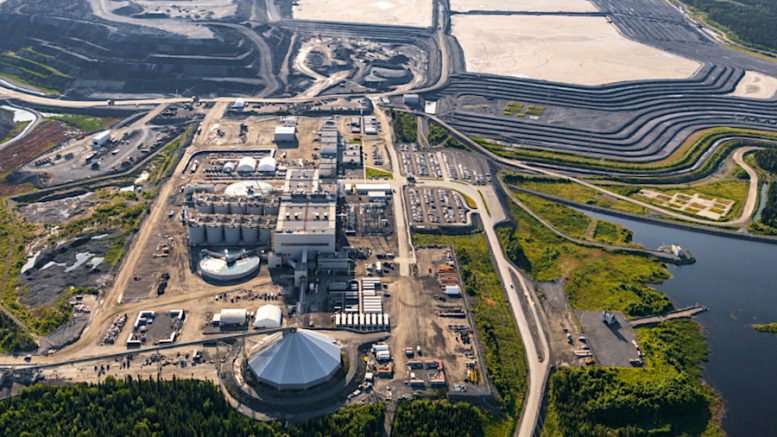Agnico Eagle Mines (TSX: AEM; NYSE: AEM) delivered solid operating performance in a challenging cost and workforce environment during the fourth quarter and throughout 2022, with payable gold production of nearly 800,000 oz. and 3.1 million oz. in these periods respectively, the company reported on Friday.
The full-year production figure represents the highest ever recorded in the Canadian gold miner’s history, and a 50% increase over the payable gold production of 2.1 million oz. in 2021. Including output from the mines acquired through its takeover of Kirkland Lake Gold in February 2022, Agnico’s total payable gold production in 2022 was 3.3 million ounces.
“It was a transformational year for Agnico Eagle. The merger with Kirkland Lake Gold and the pending acquisition of Yamana’s Canadian assets will result in the consolidation of the Abitibi Gold Belt, one of the best gold regions in the world,” Ammar Al-Joundi, Agnico’s president and CEO, commented in a news release.
In November, Agnico entered an agreement with Yamana Gold (TSX: YRI; NYSE: AUY) that would see the company expand its Canadian portfolio through the acquisition of Yamana’s interests in the Canadian Malartic mine, the Wasamac project in Quebec, and several other exploration properties in Ontario and Manitoba. This deal is expected to close next month.
“From a safety and operational standpoint, 2022 was another strong year as we had our best safety performance in our 66 year history, we met production forecasts and managed our costs in a highly inflationary environment,” he added.
All-in sustaining costs (AISC) for the fourth quarter and full-year 2022 were US$1,231 and US$1,109 per oz.. respectively. The higher quarterly unit costs were affected by the impact of inflationary pressures at the Nunavut and Kittila operations and lower production at LaRonde, Kittila and Pinos Altos, according to the company.
During the year, Agnico also managed to grow its mineral reserve base to a record level, totalling 48.7 million oz. of gold (1.2 billion tonnes grading 1.28 grams per tonne) for a 9% increase. The year-over-year increase in reserves is largely due to significant additions at Detour Lake as well as successful conversion of mineral resources at several other operations, Agnico said.
At year-end, Agnico had measured and indicated resources of 44.2 million oz. (1.2 billion tonnes grading 1.17 grams gold) and inferred resources of 26.3 million oz. (311 million tonnes grading 2.63 grams gold).
Despite reporting a record annual gold production, Agnico’s shares were down by 8% as of 1 p.m. ET. This would give the company a current market value of $27.8 billion.
2023 plans
In 2023, Agnico said it will focus on optimizing its expanded strategic positions in the Abitibi region of Ontario and Quebec, with the aim of increasing profitable gold production. The company will also evaluate opportunities to leverage existing infrastructure that has the potential to significantly increase future production.
Focus will be placed on the Detour Lake mine, where the company is hoping to optimize the mill processes and improve runtime to achieve, and potentially surpass, a throughput of 28 million tonnes per year. It will also look to extend the mineralization to the west with the aim of establishing an initial underground mineral resource.
At the Odyssey project, underground development remains on schedule with initial production and start of shaft sinking expected in March 2023. Delineation drilling of the internal zones at Odyssey South in 2022 showed potential to add production in 2024-2026, and this year’s exploration expected to focus on further testing of these zones.
At Canadian Malartic, which will combine with Odyssey to form the Canadian Malartic Complex, Agnico expects to have up to 40,000 tonnes per day of excess mill capacity starting in 2028, while at the LaRonde Complex, the company could have up to 2,000 tonnes per day of excess mill capacity at the LaRonde Zone 5 mill circuit starting in the second quarter of 2023.
By maximizing the mill throughput in the region, the company believes there is potential to increase future gold production at lower capital costs and a reduced environmental footprint, which could also be beneficial to facilitating the permitting process.
Additional production could begin at approximately 20,000 ounces in 2024, and according to chief executive Al-Joundi, there is “potential to produce up to 500,000 ounces of gold per year by the end of the decade.”
With these plans in place, Agnico’s 2023 gold production is now forecast to be approximately 3.24 to 3.44 million oz., in line with previous guidance. This production forecast assumes 50% ownership of Canadian Malartic for the first three months and of 100% ownership for the last nine months of the year.
The additional production from Canadian Malartic, combined with improvements in Amaruq’s production profile, will be offset by revisions to the mine plans at LaRonde, Fosterville, Kittila and Pinos Altos, the company explained.
Looking ahead, Agnico’s gold production is expected to increase by around 7% through 2025 based on mid-point estimates when compared to the 2022 figure. Gold production is forecast to be approximately 3.35 to 3.55 million oz. in 2024 and 3.4 to 3.6 million oz. in 2025.


Be the first to comment on "Agnico Eagle shares sink despite record gold production in 2022"